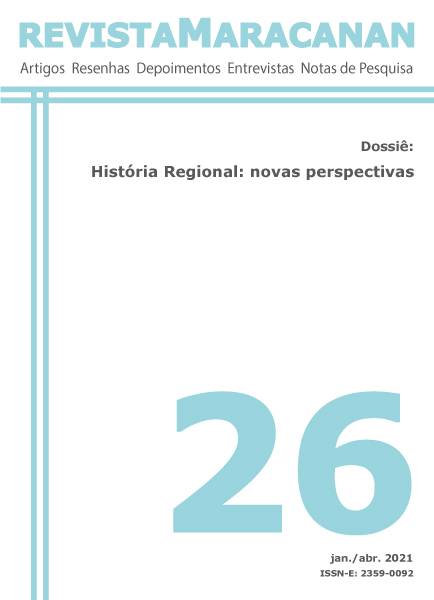Os indesejados da seca: a imagem do sertanejo desde as narrativas da Revista do Instituto do Ceará ao Campo de Concentração do Alagadiço (1887-1915)
DOI:
https://doi.org/10.12957/revmar.2021.54435Palavras-chave:
Revista do Instituto do Ceará, Campo de Concentração do Alagadiço, Seca, SertanejosResumo
O presente artigo trata das imagens construídas sobre o sertanejo, desde as narrativas do Instituto do Ceará até a criação do campo de concentração do Alagadiço, na seca de 1915. Para isso, analisaremos como o Instituto do Ceará, criado em 1887, através da sua Revista do Instituto do Ceará, vinculou o pioneirismo cearense em relação à abolição da escravatura também ao fato da província ser acometida pela seca. A ideia da natureza ser condicionante da vida da região e ser uma narrativa construída historicamente para retratar o Ceará, fez parte do pensamento da elite que estava à frente do Instituto, e é parte fundamental do que se vai narrar sobre os sertões, os sertanejos, seus costumes, seus modos de ser e agir nos anos posteriores. Nesse sentido, a seca ganha espaço como campo de lutas que também são simbólicas, e justificam medidas segregadoras e excludentes como o campo de concentração do Alagadiço. Por meio de ofícios e relatórios do governo e da Inspetoria de Obras Contra as Secas (IOCS), propomos uma reflexão acerca dos discursos que estavam na ordem do dia na seca de 1877 e que fizeram parte da narrativa da própria criação do campo do Alagadiço em 1915.
Referências
ALBUQUERQUE JÚNIOR, Durval Muniz. A invenção do Nordeste e outras artes. São Paulo: Cortez, 2011.
ALBUQUERQUE JÚNIOR, Durval Muniz. Preconceito contra a origem geográfica e de lugar: As fronteiras da discórdia. São Paulo: Cortez, 2012.
ALBUQUERQUE JÚNIOR, Duval Muniz. Receitas Regionais: a noção de região como um ingrediente da historiografia brasileira ou o regionalismo como um modo de preparo historiográfico. Anais do [...] XIII Encontro de História da ANPUH-Rio. Seropédica, RJ: ANPUH-Rio, 2008.
BOURDIEU, Pierre. A identidade e a representação: elementos para uma reflexão crítica sobre a ideia de região. In: O Poder Simbólico. Rio de Janeiro: Bertrand, 1989.
CARDOSO, Gleudson Passos. As Repúblicas das letras cearenses: literatura, imprensa e política (1873-1904). 2000. Dissertação (Mestrado) - Pontifícia Universidade Católica de São Paulo, São Paulo.
COSTA FILHO, Cícero João da. Padaria Espiritual: cultura e política em Fortaleza no final do século XIX (1892-1898). 2007. Dissertação (Mestrado) – Faculdade de Filosofia, Letras e Ciências Humanas da Universidade de São Paulo, São Paulo.
FREIRE, Camila de Sousa. O Instituto do Ceará e a identidade regional a partir do movimento abolicionista cearense (1884-1956). 2018. Dissertação (Mestrado em História Social) – Universidade do Estado do Rio de Janeiro, São Gonçalo (RJ).
FROTA, Luciara Silveira de Aragão. Documentação Oral e a temática da Seca. Brasília: Centro Gráfico, 1985.
MARTINS, José de Souza. Os camponeses e a política no Brasil. As lutas sociais no campo e seu lugar no processo político. Petrópolis, RJ: Vozes, 1983,
MELO, Leda Agnes Simões de. O trabalho em tempos de calamidade: a Inspetoria de Obras nos campos de concentração do Ceará (1915 e 1932). 2015. Dissertação (Mestrado em Ciências Sociais em Desenvolvimento, Agricultura e Sociedade) – Universidade Federal Rural do Rio de Janeiro, Seropédica (RJ)
MORAES, Kleiton de Sousa. O sertão descoberto aos olhos do progresso: a Inspetoria de Obras Contra as Secas (1909-1918). 2010. Dissertação (Mestrado em História Social) – Universidade Federal do Rio de Janeiro, Rio de Janeiro.
NEVES, Frederico de Castro. “Desbriamento” e “perversão”: olhares ilustrados sobre os retirantes da seca de 1877. Projeto História, São Paulo, n. 27, p. 167-189, dez. 2003.
OLIVENOR, José. “Metrópole da fome”: a cidade de Fortaleza na seca de 1877-1879. In: SOUZA, Simone de; NEVES, Frederico de Castro (Orgs.). Seca. Fortaleza: Demócrito Rocha, 2015.
PINHEIRO NETO, Armando. De curral da fome a campo santo: o campo de concentração de retirantes na seca de 1915 em Fortaleza. 2014. Dissertação (Mestrado) - Universidade Federal do Estado do Rio de Janeiro, Rio de Janeiro.
QUEIROZ, Rachel. O Quinze. Rio de Janeiro: José Olympio, 2013.
ROLNIK. Raquel. A cidade e a lei. Legislação, política urbana e território na cidade de São Paulo. São Paulo: FAPESP, 1997.
SILVA, Ana Paula Barcelos Ribeiro da. “Nem História nem mesmo Chronica”: escrita da história, identidade e integração nacional no intercâmbio entre o IHGB e o Instituto do Ceará (1889-1931). Revista do Instituto Histórico e Geográfico Brasileiro, Rio de Janeiro, ano 177, n. 471, p. 101-124, abr.-jun. 2016.
TAVARES, M. C.; ANDRADE, M. C.; PEREIRA, R. (Entrevistadores). Seca e Poder: entrevista com Celso Furtado. São Paulo: Fundação Perseu Abramo, 1998.
TEÓFILO, Rodolfo. A Seca de 1915. Fortaleza: Ed. UFC, 1980.
TODOROV, Tzvetan. A vida em comum: Ensaio de Antropologia Geral. São Paulo: Ed. Unesp, 2014.
Downloads
Publicado
Como Citar
Edição
Seção
Licença
Os autores mantêm os direitos autorais e concedem à Revista Maracanan o direito de publicação, sob uma Licença Creative Commons Atribuição 4.0 Internacional, a qual permite que outros distribuam, remixem, adaptem e criem a partir do seu trabalho, mesmo para fins comerciais, desde que lhe atribuam o devido crédito pela criação original.
Os dados e conceitos abordados são da exclusiva responsabilidade do autor.
A Revista Maracanan está licenciada com uma Licença Creative Commons Atribuição 4.0 Internacional.





